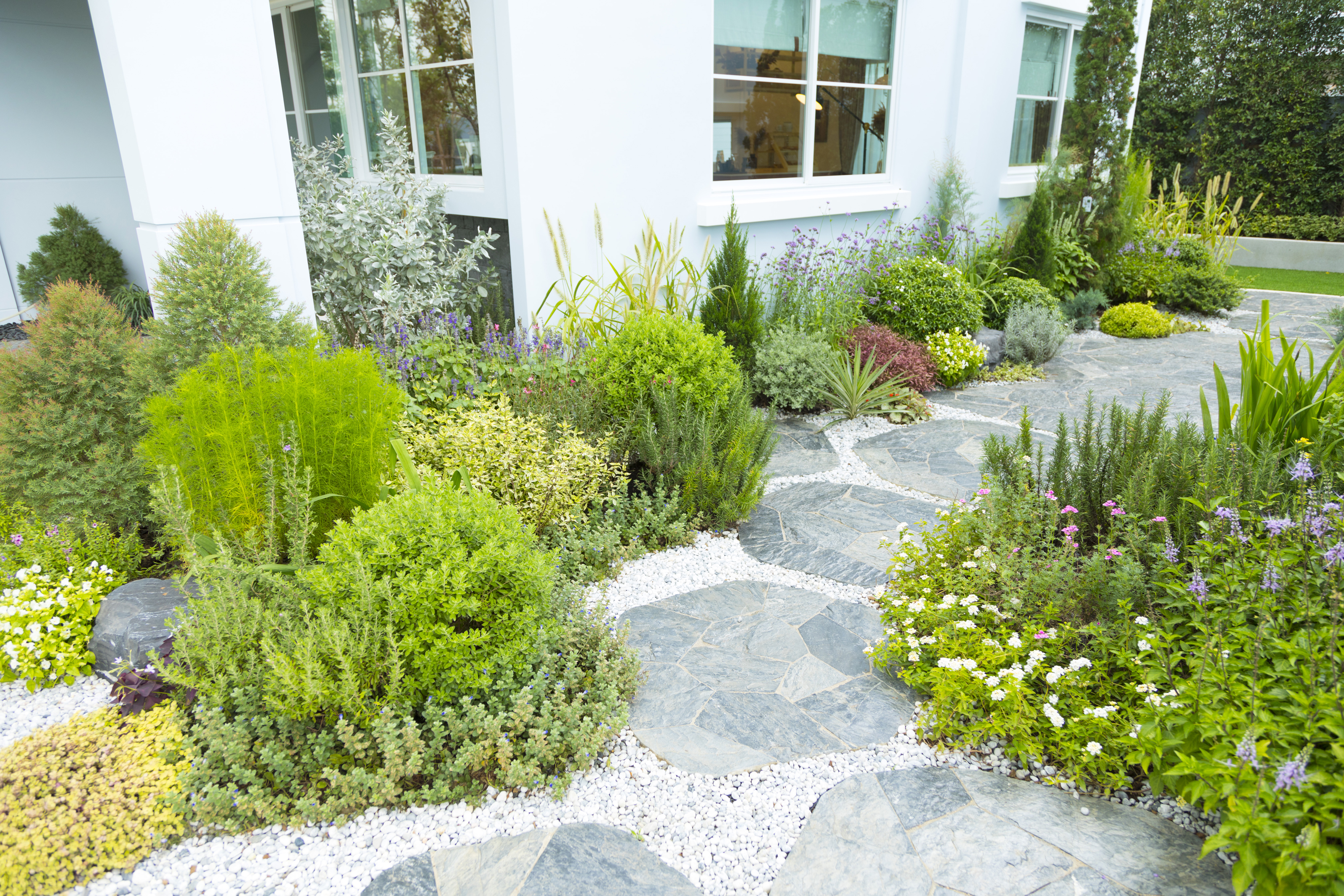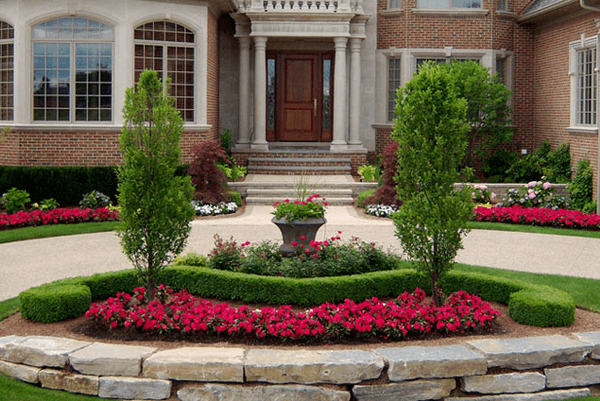Why Hiring a Licensed Landscaping Contractor Matters for Safe Results
Transform Your Garden With Innovative Landscape Design Methods and concepts
Changing a garden requires thoughtful consideration of its special attributes. Effective landscape Design can enhance both performance and aesthetic appeal. By checking out various techniques, one can produce a room that not just mirrors individual style however also sustains regional biodiversity. As the trip unfolds, concerns about plant selection, design, and sustainability emerge, triggering a deeper expedition right into just how to make these ideas come to life.
Evaluating Your Outdoor Space: Understanding Your Yard's Prospective
Examining exterior area is crucial for efficient landscape layout. Comprehending the unique features of a yard enables developers to optimize its possibility. Elements such as dirt quality, sunlight exposure, and existing structures play an important role in determining what can be accomplished. Analyzing the topography aids determine areas for growing, courses, or water features, while noting drain patterns ensures that plants thrive without waterlogging.
Additionally, identifying the garden's microclimates can influence plant option and placement. Observing exactly how the room is used by residents educates useful Design choices, such as seating locations or play zones. Furthermore, taking into consideration the bordering environment and bordering landscapes can provide inspiration and context for Design decisions. By extensively checking out these components, one can develop a natural and inviting exterior room that reflects the proprietor's vision while balancing with nature. Ultimately, a detailed analysis prepares for an effective landscape Design task.
Selecting the Right Plants: A Guide to Shade, Texture, and Seasonal Passion
When choosing plants for a landscape layout, recognizing the interplay of color, texture, and seasonal interest is crucial for creating a dynamic and lively yard. Shade can evoke feelings and set the tone for the area; subsequently, selecting an unified scheme boosts aesthetic charm. Cozy tones like oranges and reds develop energy, while cooler colors like blues and environment-friendlies supply tranquility.
Appearance includes depth and measurement, permitting a mix of foliage sizes and shapes. Combining fine-textured plants with bold-leaved ranges produces contrast and intrigue.
Seasonal interest is necessary for maintaining year-round beauty. Selecting a selection of plants that bloom in different seasons warranties that the garden remains vibrant, changing from springtime's vivid flowers to fall's abundant vegetation. By attentively thinking about these elements, one can curate a landscape that is not just visually pleasing however interesting and additionally varied throughout the year.

Creating Functional Areas: Creating Spaces for Relaxation and Amusement
Developing useful zones in a landscape Design enhances the functionality of outside areas, permitting property owners to effortlessly mix relaxation and home entertainment. By thoughtfully separating areas right into unique areas, people can deal with different activities, from silent hideaways to vibrant celebrations. A properly designed space may integrate a comfy reading space nestled among lush greenery, supplying a peaceful escape (Landscaper). In comparison, a lively outdoor dining area can act as the best setup for parties with family and pals
Strategically positioned pathways can assist guests between these areas, ensuring very easy navigation. Additionally, incorporating elements like seating locations, fire pits, or water features can boost the total setting and functionality. The integration of varied appearances and colors in each zone can produce visual rate of interest while maintaining a cohesive visual. Ultimately, designing useful zones allows house owners to maximize their exterior experience, changing their gardens into flexible rooms that satisfy diverse lifestyle needs.
Including Hardscape Elements: Patios, Walkways, and Focal Information
Incorporating hardscape aspects right into landscape Design matches practical areas by supplying structure and aesthetic allure. Patios act as necessary exterior space, permitting house owners to appreciate meals and events in a defined location while enhancing accessibility. The choice of materials, such as all-natural rock or concrete, can considerably influence the general visual, blending seamlessly with the surrounding setting.
Pathways facilitate motion through the garden, directing site visitors while adding depth and rate of interest. These paths can be crafted from different materials, consisting of crushed rock, pavers, or block, each contributing to the garden's character.
Focal points, such as decorative boulders, sculptures, or water functions, draw the eye and create a sense of purpose within the landscape. Strategically positioned, these elements can transform a regular garden into a fascinating area, inviting exploration and involvement. Via thoughtful assimilation of hardscape, a landscape comes to be not only practical however likewise visually magnificent.
Enhancing Personal Privacy and Safety: Natural Obstacles and Frameworks
To improve personal privacy and safety in landscape style, making use of natural barriers such as dense hedges can successfully secure a residential or commercial property from undesirable sights. In addition, mounting personal privacy fences gives a strong framework that adds to a sense of safety and seclusion. Together, these elements develop an even more intimate outdoor room while discouraging possible intrusions.
Planting Dense Hedges
While numerous property owners look for aesthetic appeal in their landscapes, growing dense bushes offers a double purpose of enhancing privacy and protection. These natural barriers develop a visual guard, successfully blocking the view from prying eyes and deterring possible trespassers. Various types, such as boxwood, holly, or privet, can be chosen for their development patterns and foliage thickness, making sure rich coverage throughout the year. In addition, well-kept hedges can add to a peaceful environment, absorbing sound and supplying a habitat for wildlife. The critical placement of these bushes can specify property boundaries and create secluded outdoor areas, allowing property owners to appreciate their gardens with a sense of safety. Eventually, thick hedges are an effective option for mixing elegance with capability.
Installing Personal Privacy Fences
Privacy fencings offer as an additional effective approach for boosting privacy and safety and security in property landscapes. These structures not just define property borders but additionally create a feeling of privacy, securing homeowners from spying eyes. Various products, such as timber, steel, and vinyl, deal distinctive appearances and degrees of sturdiness, permitting home owners to select based upon their Design choices and maintenance demands.

Lasting Landscaping: Eco-Friendly Practices for a Greener Yard
Sustainable landscaping highlights the significance of indigenous plant choice and water preservation methods. By selecting plants that are well-adapted to the local setting, garden enthusiasts can decrease maintenance and source use. Carrying out reliable sprinkling techniques further enhances the garden's eco-friendly benefits, promoting a much healthier community.
Indigenous Plant Selection
Native plant option plays a crucial duty in sustainable landscaping, advertising biodiversity and minimizing the demand for chemical inputs. By selecting plants native to a details region, garden enthusiasts can develop habitats that sustain regional wild animals, such as pollinators, birds, and advantageous bugs. These plants are adapted to the regional climate and dirt problems, requiring much less water and upkeep contrasted to non-native species. Furthermore, native plants can assist manage erosion and enhance dirt health, promoting a well balanced ecosystem. Incorporating native varieties right into landscape develops not just improves the visual appeal of the garden however likewise adds to environmental resilience. Eventually, indigenous plant choice is a crucial technique for those seeking to cultivate a lasting and vibrant yard.
Water Preservation Techniques
Integrating indigenous plants can greatly improve water preservation initiatives in landscape design. These plants are well-adapted to regional environments, calling for much less water and maintenance than non-native selections. Implementing drip watering systems permits targeted watering, decreasing evaporation and overflow. Rainwater gathering systems can also be mounted, storing and collecting rainwater for yard usage. Mulching helps preserve soil dampness, reducing the regularity of watering. Grouping plants with comparable water needs with each other creates efficient sprinkling zones, better conserving water. Additionally, using absorptive materials for pathways allows rain to permeate get more info right into the ground, replenishing groundwater products. By using these water preservation strategies, garden enthusiasts can create lasting landscapes that prosper while decreasing ecological effect (Landscape Architect). Such techniques add to a greener garden and a much healthier environment
Individualizing Your Style: Adding Special Features and Personal Touches
Just how can one change a yard into a personal sanctuary? Customizing a landscape Design includes incorporating special attributes that mirror individual tastes and lifestyles. One technique is to include customized garden art, such as sculptures or handmade birdhouses, which can offer as centerpieces and discussion beginners. In enhancement, tailoring plant options based upon seasonal flowers or individual preferences can create a vivid and developing area.
Creating functional locations, such as a comfortable analysis space or an outside dining room, can enhance use and convenience. Incorporating aspects like a fire pit or a water attribute can introduce an inviting atmosphere.
Shade products, structures, and plans must align with the house owner's style, whether it be modern, rustic, or eclectic. Inevitably, the objective is to develop a room that resonates with the person's identification, making the garden not simply a visual delight but a true extension of the home owner's personality.
Frequently Asked Concerns
How Do I Budget for a Landscape Design Job?
To budget plan for a landscape Design task, one need to analyze project range, research study prices for products and labor, focus on functions, and assign an added 10-20% for unexpected expenditures, ensuring a sensible financial plan.
What Devices Are Necessary for Home Garden Landscaping?
Essential devices for home garden landscape design include a shovel, rake, yard fork, pruning shears, trowel, wheelbarrow, and hoe. These instruments aid in soil preparation, planting, maintenance, and reliable transportation of products throughout the landscaping project.
Exactly How Can I Preserve My Yard After Upgrading?
To keep an upgraded garden, routine watering, mulching, weeding, and pruning are vital (Landscaper). Surveillance plant health and wellness, adjusting get more info dirt nutrients, and seasonal plant treatment contribute to a growing setting that showcases the garden's new Design properly
When Is the most effective Time to Begin Landscaping?

Can I DIY My Landscape Design or Should I Work with an Expert?
Individuals can certainly DIY their landscape Design if they possess imagination and fundamental skills; however, employing a professional often assures an extra professional and cohesive result, especially for intricate tasks or certain Design ambitions.
Acknowledging the garden's microclimates can affect plant option and positioning. When choosing plants for a landscape design, recognizing the interaction of color, appearance, and seasonal passion is essential for producing a lively and vibrant yard. Choosing a selection of plants that bloom in various periods warranties that the yard stays dynamic, changing from spring's dynamic flowers to autumn's abundant vegetation. Incorporating indigenous types into landscape develops not just enhances the visual appeal of the garden yet check here likewise contributes to environmental strength. Necessary tools for home yard landscaping consist of a shovel, rake, garden fork, pruning shears, trowel, hoe, and wheelbarrow.